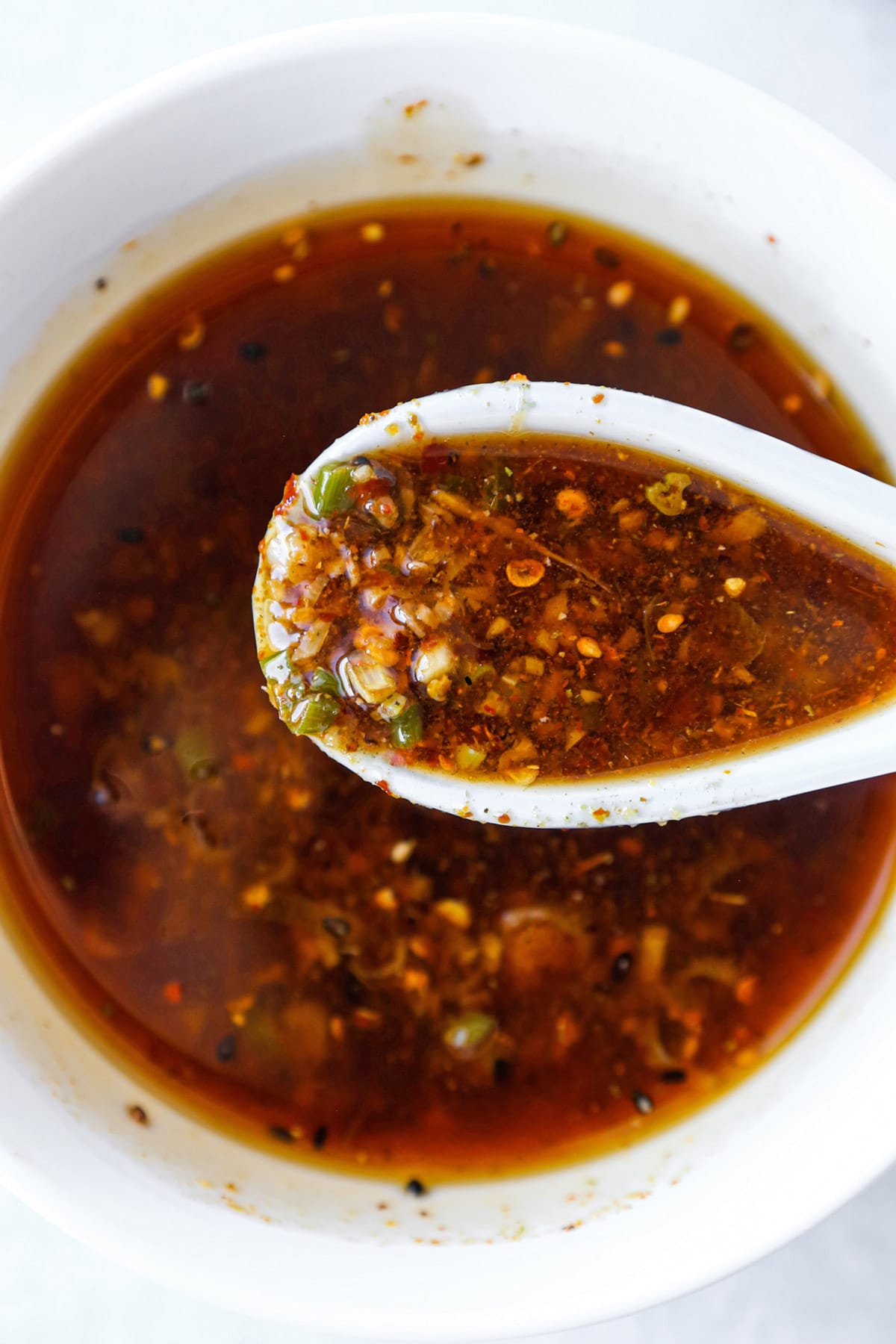Like it spicy? This homemade taberu rayu is loaded with garlic, scallions, and ginger. This fiery red flavored oil will round out your Japanese favorites such as gyoza and ramen.

What is Rayu?
Rāyu (ラー油) is Japanese chili oil. This delicious Japanese condiment is used to introduce smoky heat to things like ramen, gyoza dipping sauce, soups or even pasta.
Now, there are actually two different types of rayu.
- Traditional rayu, layu, or la-yu. This is the most common type of Japanese chili oil available. You may be familiar with the small but iconic S&B bottle on the shelves at your local Asian market.
- Taberu rayu (食べるラー油), which translates roughly into rayu meant for eating. This chunky chili oil is fortified with bits of crunchy garlic, ginger and spring onion. It can be used in the same ways as the smooth oil – or you can serve the chunky bits on top of a bowl of rice.
We’re making the latter today. However, this spicy rayu actually pulls double duty – and can be served however you prefer. More on that in a sec.
This addictive Japanese chili oil is Ben’s new favorite – and he has been adding it to (almost) everything. While he has an unusually high tolerance for spicy foods, I’d rate the spice level at about a 7 or so. It packs a punch!

Ingredients for Rayu
Scroll all the way down for the full recipe.
- Ginger and Garlic: You’ll want a finely chopped tablespoon of each for this rayu recipe. The ginger brings a zing and some heat – while garlic lends its trademark pungency to the mix. And, in my opinion – there’s nothing better than bits of crunchy garlic in chili oil!
- Scallions: Fresh green onions are herbaceous – but when they’re cooked in oil they take on an almost toasted onion quality. A must!
- Cinnamon Stick and Star Anise: While cinnamon and star anise might be something you’d typically associate with five-spice powder used in Vietnamese and Chinese cuisine, it goes so well in this Japanese chili oil, delivering yet another layer to the multifaceted flavor profile.
- Toasted Sesame Oil: This nutty and intensely toasty oil has a relatively low smoking point. So you’ll want to make sure not to scorch the oil when cooking.
- Ichimi Togarashi: This is ground red Japanese chili pepper powder. It’s a great way to add heat to this dish without being overtly volcanic. If you’re having trouble finding it at your corner shop, you can grab ichimi togarashi here on Amazon. A workable substitute would be to use gochugaru instead (a smoky Korean chili powder).
- Chinese Red Pepper Flakes: These dried chili flakes are actually hot! I like to use a tablespoon myself for this rayu recipe – but you can use a bit more (or less if you prefer things on the milder side).
- Salt: This is optional, but a pinch will go a long way toward rounding out the savory nature of this homemade chili oil.

How to Make Chili Oil
- Gather all of your kitchen tools and ingredients.
- Add half of the oil to a small pot, and add in the chopped ginger, garlic, scallions, the whole cinnamon stick and star anise. Turn the heat to low and let the oil simmer for 3 to 5 minutes. You should only see small bubbles at this point. Large bubbles means that the heat is too high. Seriously, keep it on low heat. Don’t scorch your homemade chili oil!
- Turn the heat off and stir in your remaining sesame oil, ichimi togarashi and Chinese red pepper flakes.
- Add a pinch of salt for extra flavor.
- Let the rayu sit in the pan until it reaches room temperature. Once it has cooled, discard the cinnamon stick and the star anise pods. Transfer everything else to a glass jar.
- When serving, you have two options:
- Chili oil only (rāyu). If you’re looking for smooth oil without crunchy bits, don’t shake the jar! Simply scoop the flavored oil from the top of the jar with a spoon. You can also strain the oil through cheesecloth or a sieve.
- Crispy chili oil (taberu rāyu). If you prefer to enjoy this chili oil recipe in all its glory with the crispy garlic, ginger and scallions, you can shake the jar prior to serving so that all the ingredients are mixed well.

How to Use Rayu
As I mentioned, this Japanese chili oil is most iconically used to round out a dish. It is the best spicy ad-in to complete a steaming bowl of tonkotsu ramen.
And it can really elevate something like a dipping sauce to new levels. Check out these easy recipes for both Japanese and Chinese dumpling sauces.
But this taberu rayu also has great crossover appeal. You could use it as a stand alone dipping sauce when eating Chinese dim sum.
Now, while rayu is typically used as a condiment, it can also technically be used as a cooking ingredient as part of a composed dish. Ben has been using it as a base for some of his late-night East-meets-West pasta inventions.

How to store Japanese Chili Oil
Rayu chili oil can be stored in a glass storage jar at room temperature for about two months. I prefer to place it in a dark, cool cupboard to keep the vibrant reddish tint from changing color due to sun exposure.
Trust me, this stuff will come in handy! You never know when you’ll need to need to make a midnight bowl of ramen or whip up some crispy, pan-fried gyoza dumplings!

Other Easy Asian Sauces
As a home chef, I find it’s always a good thing to have a few condiments and easy sauce recipes in your back pocket. Hey – if you’re like me, you like to keep it saucy too!
Here are a few reader favorites:
- Hot Sichuan Chili Oil
- Quick Homemade Gochujang (Korean Chili Paste)
- Yakisoba Sauce
- Crazy Hot Chili Garlic Sauce
- Quick and Easy Tonkatsu Sauce
Did you like this homemade rayu recipe? Are there changes you made that you would like to share? Share your tips and recommendations in the comments section below!
Print
Homemade Rayu – Japanese Chili Oil
- Prep Time: 10 minutes
- Cook Time: 5 minutes
- Total Time: 15 minutes
- Yield: about 3/4 cup 1x
- Category: Condiment
- Method: Stove top
- Cuisine: Japanese
- Diet: Vegan
Description
This homemade taberu rayu is loaded with garlic, scallions, and ginger. This fiery red flavored oil will round out your Japanese favorites such as gyoza and ramen.
Ingredients
- 1 tablespoon ginger, peeled and finely chopped
- 1 tablespoon garlic, peeled and finely chopped
- 2 tablespoons finely chopped scallions
- 1 cinnamon stick
- 2 star anise
- 3/4 cup toasted sesame oil
- 2 teaspoons ichimi togarashi
- 1 tablespoon Chinese red pepper flakes
- Pinch of salt (optional)
Instructions
- Add the ginger, garlic, scallions, cinnamon stick, star anise, and half of the oil to a small pot. Turn the heat to low and let the oil simmer until small bubbles begin to appear, about 3 to 5 minutes.
- Turn the heat off and stir in the remaining sesame oil, ichimi togarashi, and Chinese red pepper flakes.
- Add a pinch of salt for extra flavor.
- Leave until the oil reaches room temperature, discard the cinnamon stick and star anise, and transfer the rest to a jar.
- When using the flavored oil only, leave the ingredients at the bottom (do not stir) and scoop the oil from the top. Or you can strain the oil by running it through a cheesecloth or a fine sieve. When using chunky taberu rayu, stir well so everything is well mixed.
Notes
How to store the oil: Keep the oil in a dark storage area like a cupboard to prevent the color from changing. It will keep for about 2 months.
Nutrition
- Serving Size: 1 tablespoon
- Calories: 124
- Sugar: 0.3g
- Sodium: 7.3mg
- Fat: 13.7g
- Saturated Fat: 1.9g
- Unsaturated Fat: 5.7g
- Trans Fat: 0g
- Carbohydrates: 0.7g
- Fiber: 0.1g
- Protein: 0.1g
- Cholesterol: 0mg















I plan to try this but using dehydrated ingredients. I like the crunchy texture. I will try and let you know how it turns out.